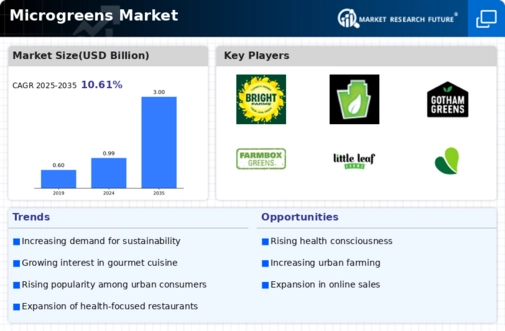Leafy Microgreens
Cruciferous Microgreens
Herb Microgreens
Fruit Microgreens
Online Stores
Supermarkets
Farmers Markets
Specialty Health Stores
Household
Food Service
Food Processing
Soil-Based
Hydroponics
Aeroponics
North America
Europe
South America
Asia Pacific
Middle East and Africa
North America Outlook (USD Billion, 2019-2035)
North America Microgreens Market by Type
Leafy Microgreens
Cruciferous Microgreens
Herb Microgreens
Fruit Microgreens
North America Microgreens Market by Distribution Channel Type
Online Stores
Supermarkets
Farmers Markets
Specialty Health Stores
North America Microgreens Market by End Use Type
Household
Food Service
Food Processing
North America Microgreens Market by Growing Method Type
Soil-Based
Hydroponics
Aeroponics
North America Microgreens Market by Regional Type
US
Canada
US Outlook (USD Billion, 2019-2035)
US Microgreens Market by Type
Leafy Microgreens
Cruciferous Microgreens
Herb Microgreens
Fruit Microgreens
US Microgreens Market by Distribution Channel Type
Online Stores
Supermarkets
Farmers Markets
Specialty Health Stores
US Microgreens Market by End Use Type
Household
Food Service
Food Processing
US Microgreens Market by Growing Method Type
Soil-Based
Hydroponics
Aeroponics
CANADA Outlook (USD Billion, 2019-2035)
CANADA Microgreens Market by Type
Leafy Microgreens
Cruciferous Microgreens
Herb Microgreens
Fruit Microgreens
CANADA Microgreens Market by Distribution Channel Type
Online Stores
Supermarkets
Farmers Markets
Specialty Health Stores
CANADA Microgreens Market by End Use Type
Household
Food Service
Food Processing
CANADA Microgreens Market by Growing Method Type
Soil-Based
Hydroponics
Aeroponics
Europe Outlook (USD Billion, 2019-2035)
Europe Microgreens Market by Type
Leafy Microgreens
Cruciferous Microgreens
Herb Microgreens
Fruit Microgreens
Europe Microgreens Market by Distribution Channel Type
Online Stores
Supermarkets
Farmers Markets
Specialty Health Stores
Europe Microgreens Market by End Use Type
Household
Food Service
Food Processing
Europe Microgreens Market by Growing Method Type
Soil-Based
Hydroponics
Aeroponics
Europe Microgreens Market by Regional Type
Germany
UK
France
Russia
Italy
Spain
Rest of Europe
GERMANY Outlook (USD Billion, 2019-2035)
GERMANY Microgreens Market by Type
Leafy Microgreens
Cruciferous Microgreens
Herb Microgreens
Fruit Microgreens
GERMANY Microgreens Market by Distribution Channel Type
Online Stores
Supermarkets
Farmers Markets
Specialty Health Stores
GERMANY Microgreens Market by End Use Type
Household
Food Service
Food Processing
GERMANY Microgreens Market by Growing Method Type
Soil-Based
Hydroponics
Aeroponics
UK Outlook (USD Billion, 2019-2035)
UK Microgreens Market by Type
Leafy Microgreens
Cruciferous Microgreens
Herb Microgreens
Fruit Microgreens
UK Microgreens Market by Distribution Channel Type
Online Stores
Supermarkets
Farmers Markets
Specialty Health Stores
UK Microgreens Market by End Use Type
Household
Food Service
Food Processing
UK Microgreens Market by Growing Method Type
Soil-Based
Hydroponics
Aeroponics
FRANCE Outlook (USD Billion, 2019-2035)
FRANCE Microgreens Market by Type
Leafy Microgreens
Cruciferous Microgreens
Herb Microgreens
Fruit Microgreens
FRANCE Microgreens Market by Distribution Channel Type
Online Stores
Supermarkets
Farmers Markets
Specialty Health Stores
FRANCE Microgreens Market by End Use Type
Household
Food Service
Food Processing
FRANCE Microgreens Market by Growing Method Type
Soil-Based
Hydroponics
Aeroponics
RUSSIA Outlook (USD Billion, 2019-2035)
RUSSIA Microgreens Market by Type
Leafy Microgreens
Cruciferous Microgreens
Herb Microgreens
Fruit Microgreens
RUSSIA Microgreens Market by Distribution Channel Type
Online Stores
Supermarkets
Farmers Markets
Specialty Health Stores
RUSSIA Microgreens Market by End Use Type
Household
Food Service
Food Processing
RUSSIA Microgreens Market by Growing Method Type
Soil-Based
Hydroponics
Aeroponics
ITALY Outlook (USD Billion, 2019-2035)
ITALY Microgreens Market by Type
Leafy Microgreens
Cruciferous Microgreens
Herb Microgreens
Fruit Microgreens
ITALY Microgreens Market by Distribution Channel Type
Online Stores
Supermarkets
Farmers Markets
Specialty Health Stores
ITALY Microgreens Market by End Use Type
Household
Food Service
Food Processing
ITALY Microgreens Market by Growing Method Type
Soil-Based
Hydroponics
Aeroponics
SPAIN Outlook (USD Billion, 2019-2035)
SPAIN Microgreens Market by Type
Leafy Microgreens
Cruciferous Microgreens
Herb Microgreens
Fruit Microgreens
SPAIN Microgreens Market by Distribution Channel Type
Online Stores
Supermarkets
Farmers Markets
Specialty Health Stores
SPAIN Microgreens Market by End Use Type
Household
Food Service
Food Processing
SPAIN Microgreens Market by Growing Method Type
Soil-Based
Hydroponics
Aeroponics
REST OF EUROPE Outlook (USD Billion, 2019-2035)
REST OF EUROPE Microgreens Market by Type
Leafy Microgreens
Cruciferous Microgreens
Herb Microgreens
Fruit Microgreens
REST OF EUROPE Microgreens Market by Distribution Channel Type
Online Stores
Supermarkets
Farmers Markets
Specialty Health Stores
REST OF EUROPE Microgreens Market by End Use Type
Household
Food Service
Food Processing
REST OF EUROPE Microgreens Market by Growing Method Type
Soil-Based
Hydroponics
Aeroponics
APAC Outlook (USD Billion, 2019-2035)
APAC Microgreens Market by Type
Leafy Microgreens
Cruciferous Microgreens
Herb Microgreens
Fruit Microgreens
APAC Microgreens Market by Distribution Channel Type
Online Stores
Supermarkets
Farmers Markets
Specialty Health Stores
APAC Microgreens Market by End Use Type
Household
Food Service
Food Processing
APAC Microgreens Market by Growing Method Type
Soil-Based
Hydroponics
Aeroponics
APAC Microgreens Market by Regional Type
China
India
Japan
South Korea
Malaysia
Thailand
Indonesia
Rest of APAC
CHINA Outlook (USD Billion, 2019-2035)
CHINA Microgreens Market by Type
Leafy Microgreens
Cruciferous Microgreens
Herb Microgreens
Fruit Microgreens
CHINA Microgreens Market by Distribution Channel Type
Online Stores
Supermarkets
Farmers Markets
Specialty Health Stores
CHINA Microgreens Market by End Use Type
Household
Food Service
Food Processing
CHINA Microgreens Market by Growing Method Type
Soil-Based
Hydroponics
Aeroponics
INDIA Outlook (USD Billion, 2019-2035)
INDIA Microgreens Market by Type
Leafy Microgreens
Cruciferous Microgreens
Herb Microgreens
Fruit Microgreens
INDIA Microgreens Market by Distribution Channel Type
Online Stores
Supermarkets
Farmers Markets
Specialty Health Stores
INDIA Microgreens Market by End Use Type
Household
Food Service
Food Processing
INDIA Microgreens Market by Growing Method Type
Soil-Based
Hydroponics
Aeroponics
JAPAN Outlook (USD Billion, 2019-2035)
JAPAN Microgreens Market by Type
Leafy Microgreens
Cruciferous Microgreens
Herb Microgreens
Fruit Microgreens
JAPAN Microgreens Market by Distribution Channel Type
Online Stores
Supermarkets
Farmers Markets
Specialty Health Stores
JAPAN Microgreens Market by End Use Type
Household
Food Service
Food Processing
JAPAN Microgreens Market by Growing Method Type
Soil-Based
Hydroponics
Aeroponics
SOUTH KOREA Outlook (USD Billion, 2019-2035)
SOUTH KOREA Microgreens Market by Type
Leafy Microgreens
Cruciferous Microgreens
Herb Microgreens
Fruit Microgreens
SOUTH KOREA Microgreens Market by Distribution Channel Type
Online Stores
Supermarkets
Farmers Markets
Specialty Health Stores
SOUTH KOREA Microgreens Market by End Use Type
Household
Food Service
Food Processing
SOUTH KOREA Microgreens Market by Growing Method Type
Soil-Based
Hydroponics
Aeroponics
MALAYSIA Outlook (USD Billion, 2019-2035)
MALAYSIA Microgreens Market by Type
Leafy Microgreens
Cruciferous Microgreens
Herb Microgreens
Fruit Microgreens
MALAYSIA Microgreens Market by Distribution Channel Type
Online Stores
Supermarkets
Farmers Markets
Specialty Health Stores
MALAYSIA Microgreens Market by End Use Type
Household
Food Service
Food Processing
MALAYSIA Microgreens Market by Growing Method Type
Soil-Based
Hydroponics
Aeroponics
THAILAND Outlook (USD Billion, 2019-2035)
THAILAND Microgreens Market by Type
Leafy Microgreens
Cruciferous Microgreens
Herb Microgreens
Fruit Microgreens
THAILAND Microgreens Market by Distribution Channel Type
Online Stores
Supermarkets
Farmers Markets
Specialty Health Stores
THAILAND Microgreens Market by End Use Type
Household
Food Service
Food Processing
THAILAND Microgreens Market by Growing Method Type
Soil-Based
Hydroponics
Aeroponics
INDONESIA Outlook (USD Billion, 2019-2035)
INDONESIA Microgreens Market by Type
Leafy Microgreens
Cruciferous Microgreens
Herb Microgreens
Fruit Microgreens
INDONESIA Microgreens Market by Distribution Channel Type
Online Stores
Supermarkets
Farmers Markets
Specialty Health Stores
INDONESIA Microgreens Market by End Use Type
Household
Food Service
Food Processing
INDONESIA Microgreens Market by Growing Method Type
Soil-Based
Hydroponics
Aeroponics
REST OF APAC Outlook (USD Billion, 2019-2035)
REST OF APAC Microgreens Market by Type
Leafy Microgreens
Cruciferous Microgreens
Herb Microgreens
Fruit Microgreens
REST OF APAC Microgreens Market by Distribution Channel Type
Online Stores
Supermarkets
Farmers Markets
Specialty Health Stores
REST OF APAC Microgreens Market by End Use Type
Household
Food Service
Food Processing
REST OF APAC Microgreens Market by Growing Method Type
Soil-Based
Hydroponics
Aeroponics
South America Outlook (USD Billion, 2019-2035)
South America Microgreens Market by Type
Leafy Microgreens
Cruciferous Microgreens
Herb Microgreens
Fruit Microgreens
South America Microgreens Market by Distribution Channel Type
Online Stores
Supermarkets
Farmers Markets
Specialty Health Stores
South America Microgreens Market by End Use Type
Household
Food Service
Food Processing
South America Microgreens Market by Growing Method Type
Soil-Based
Hydroponics
Aeroponics
South America Microgreens Market by Regional Type
Brazil
Mexico
Argentina
Rest of South America
BRAZIL Outlook (USD Billion, 2019-2035)
BRAZIL Microgreens Market by Type
Leafy Microgreens
Cruciferous Microgreens
Herb Microgreens
Fruit Microgreens
BRAZIL Microgreens Market by Distribution Channel Type
Online Stores
Supermarkets
Farmers Markets
Specialty Health Stores
BRAZIL Microgreens Market by End Use Type
Household
Food Service
Food Processing
BRAZIL Microgreens Market by Growing Method Type
Soil-Based
Hydroponics
Aeroponics
MEXICO Outlook (USD Billion, 2019-2035)
MEXICO Microgreens Market by Type
Leafy Microgreens
Cruciferous Microgreens
Herb Microgreens
Fruit Microgreens
MEXICO Microgreens Market by Distribution Channel Type
Online Stores
Supermarkets
Farmers Markets
Specialty Health Stores
MEXICO Microgreens Market by End Use Type
Household
Food Service
Food Processing
MEXICO Microgreens Market by Growing Method Type
Soil-Based
Hydroponics
Aeroponics
ARGENTINA Outlook (USD Billion, 2019-2035)
ARGENTINA Microgreens Market by Type
Leafy Microgreens
Cruciferous Microgreens
Herb Microgreens
Fruit Microgreens
ARGENTINA Microgreens Market by Distribution Channel Type
Online Stores
Supermarkets
Farmers Markets
Specialty Health Stores
ARGENTINA Microgreens Market by End Use Type
Household
Food Service
Food Processing
ARGENTINA Microgreens Market by Growing Method Type
Soil-Based
Hydroponics
Aeroponics
REST OF SOUTH AMERICA Outlook (USD Billion, 2019-2035)
REST OF SOUTH AMERICA Microgreens Market by Type
Leafy Microgreens
Cruciferous Microgreens
Herb Microgreens
Fruit Microgreens
REST OF SOUTH AMERICA Microgreens Market by Distribution Channel Type
Online Stores
Supermarkets
Farmers Markets
Specialty Health Stores
REST OF SOUTH AMERICA Microgreens Market by End Use Type
Household
Food Service
Food Processing
REST OF SOUTH AMERICA Microgreens Market by Growing Method Type
Soil-Based
Hydroponics
Aeroponics
MEA Outlook (USD Billion, 2019-2035)
MEA Microgreens Market by Type
Leafy Microgreens
Cruciferous Microgreens
Herb Microgreens
Fruit Microgreens
MEA Microgreens Market by Distribution Channel Type
Online Stores
Supermarkets
Farmers Markets
Specialty Health Stores
MEA Microgreens Market by End Use Type
Household
Food Service
Food Processing
MEA Microgreens Market by Growing Method Type
Soil-Based
Hydroponics
Aeroponics
MEA Microgreens Market by Regional Type
GCC Countries
South Africa
Rest of MEA
GCC COUNTRIES Outlook (USD Billion, 2019-2035)
GCC COUNTRIES Microgreens Market by Type
Leafy Microgreens
Cruciferous Microgreens
Herb Microgreens
Fruit Microgreens
GCC COUNTRIES Microgreens Market by Distribution Channel Type
Online Stores
Supermarkets
Farmers Markets
Specialty Health Stores
GCC COUNTRIES Microgreens Market by End Use Type
Household
Food Service
Food Processing
GCC COUNTRIES Microgreens Market by Growing Method Type
Soil-Based
Hydroponics
Aeroponics
SOUTH AFRICA Outlook (USD Billion, 2019-2035)
SOUTH AFRICA Microgreens Market by Type
Leafy Microgreens
Cruciferous Microgreens
Herb Microgreens
Fruit Microgreens
SOUTH AFRICA Microgreens Market by Distribution Channel Type
Online Stores
Supermarkets
Farmers Markets
Specialty Health Stores
SOUTH AFRICA Microgreens Market by End Use Type
Household
Food Service
Food Processing
SOUTH AFRICA Microgreens Market by Growing Method Type
Soil-Based
Hydroponics
Aeroponics
REST OF MEA Outlook (USD Billion, 2019-2035)
REST OF MEA Microgreens Market by Type
Leafy Microgreens
Cruciferous Microgreens
Herb Microgreens
Fruit Microgreens
REST OF MEA Microgreens Market by Distribution Channel Type
Online Stores
Supermarkets
Farmers Markets
Specialty Health Stores
REST OF MEA Microgreens Market by End Use Type
Household
Food Service
Food Processing
REST OF MEA Microgreens Market by Growing Method Type
Soil-Based
Hydroponics
Aeroponics

















Leave a Comment